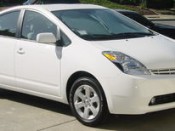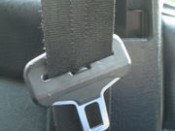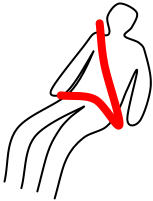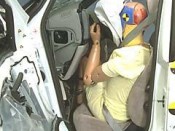
2004 Toyota Prius - a hybrid gas-electric vehicle.
A hybrid vehicle is a vehicle using an on-board Rechargeable energy storage system (RESS) and a fueled propulsion power source for vehicle propulsion. They are low-polluting and low-petro consuming cars. The different propulsion power systems may have common subsystems or components.
The term most commonly refers to petroleum-electric hybrid vehicles, also called Hybrid-electric vehicle (HEV) which use gasoline (petrol) or diesel to power internal-combustion engines (ICEs), and electric batteries to power electric motors. Modern mass-produced hybrids, such as the Toyota Prius, recharge their batteries by capturing kinetic energy via regenerative braking. As well, when cruising or in other situations where just light thrust is needed, “full” hybrids such as the Prius can use the combustion engine to generate electricity by spinning a generator (often a second electric motor) to either recharge the battery or directly feed power to an electric motor that drives the vehicle. This contrasts with all-electric cars which use batteries charged by an external source such as the grid, or a range extending trailer. Nearly all hybrids still require gasoline and diesel as their sole fuel source though other fuels such as ethanol or plant based oils have also seen occasional use. Hybrid cars also use Hydrogen gas.
The term hybrid when used in relation with cars also has other uses. Prior to its modern meaning of hybrid propulsion, the word hybrid was used in the United States to mean a vehicle of mixed national origin; generally, a European car fitted with American mechanical components. This meaning has fallen out of use. In the import scene, hybrid was often used to describe an engine swap, such as the common Honda B16 engine into a Honda Civic. Some have also referred to flexible-fuel vehicles as hybrids because they can use a mixture of different fuels — typically gasoline and ethanol alcohol fuel. There are not diesel flexible-fuel vehicles, because nowadays diesel cars can use petroleum and biodiesel at the same time.
Hybrid Vehicle History
In 1898 Ferdinand Porsche designed the Lohner-Porsche carriage, a series-hybrid vehicle that used a one-cylinder gasoline internal combustion engine that spun a generator which powered four wheel-mounted electric motors. The car was presented at the 1900 World Exhibition in Paris. The up to 56 km/h (35 mph) fast carriage broke several Austrian speed records, and also won the Exelberg Rally in 1901 with Porsche himself driving. Over 300 of the Lohner-Porsche carriages were sold to the public.
In 1959 the development of the first transistor-based electric car – the Henney Kilowatt – heralded the development of the electronic speed control that paved the way for modern hybrid electric cars. The Henney Kilowatt was the first modern production electric vehicle and was developed by a cooperative effort between National Union Electric Company, Henney Coachworks, Renault, and the Eureka Williams Company. Although sales of the Kilowatt were dismal, the development of the Kilowatt served was a historical “who’s who” of electric propulsion technology.
A more recent working prototype of the electric-hybrid vehicle was built by Victor Wouk (one of the scientists involved with the Henney Kilowatt and also brother of author Herman Wouk ). Wouk’s work with electric hybrid vehicles in the 1960s and 1970s earned him the title “Godfather of the Hybrid”. Wouk installed a prototype electric-hybrid drivetrain into a 1972 Buick Skylark provided by GM for the 1970 Federal Clean Car Incentive Program, but the program was killed by the EPA in 1976. Since then, hobbyists have continued to build hybrids but none were put into mass production by a major manufacturer until the waning years of the twentieth century.
The regenerative-braking hybrid, the core design concept of most production hybrids, was developed by Electrical Engineer David Arthurs around 1978 using off-the shelf components and an Opel GT. However, the voltage controller to link the batteries, motor (a jet-engine starter motor), and DC generator was Mr. Arthurs’. The vehicle exhibited ~75 mpg fuel efficiency and plans for it (as well as somewhat updated versions) are still available through the Mother Earth News website. The Mother Earth News’ own 1980 version of the regenerative-braking hybrid claimed nearly 84 mpg.
The Bill Clinton administration initiated the Partnership for a New Generation of Vehicles (PNGV) program in September 29, 1993 that involved Chrysler, Ford, General Motors, USCAR, the DoE, and other various governmental agencies to engineer the next efficient and clean vehicle. The NRC cited automakers’ moves to produce hybrid electric vehicles as evidence that technologies developed under PNGV were being rapidly adopted on production lines, as called for under Goal 2. Based on information received from automakers, NRC reviewers questioned whether the “Big Three†would be able to move from the concept phase to cost effective, pre-production prototype vehicles by 2004, as set out in Goal 3. [Review of the Research Program of the Partnership for a New Generation of Vehicles: Seventh Report, National Research Council, (2001), p. 77].
The program was replaced by the hydrogen focused FreedomCAR initiative of George W. Bush’s administration in 2001. The focus of the FreedomCAR initiative being to fund research too high risk for the private sector to engage in with the long term goal of developing emission / petroleum free vehicles.
In the intervening period, the widest use of hybrid technology was actually in diesel-electric submarines, which operate in essentially the same manner as hybrid electric cars. However, in this case the goal was to allow operation underwater without consuming large amounts of oxygen, rather than economizing on fuel. Since then, many submarines have moved to nuclear power, which can operate underwater indefinitely, though a number of nations continue to rely on diesel-electric fleets.
Automotive hybrid technology became successful in the 1990s when the Honda Insight and Toyota Prius became available. These vehicles have a direct linkage from the internal combustion engine to the driven wheels, so the engine can provide acceleration power. The 2000s saw development of plug-in hybrid electric vehicles (PHEVs), which can be recharged from the electrical power grid and do not require conventional fuel for short trips. The Renault Kangoo was the first production model of this design, released in France in 2003. However, the environmental benefits of plug-in hybrids depend somewhat on the source of the electrical power. In particular, electricity generated with wind would be cleaner than electricity generated with coal, the most polluting source. On the other hand, electricity generated with coal in a central power plant is still much cleaner than pure gasoline propulsion, due to the much greater efficiencies of a central plant. Furthermore, coal is only one source of centrally generated power, and in some places such as California is only a minor contributor, overshadowed by natural gas and other cleaner sources.
The Prius has been in high demand since its introduction. Newer designs have more conventional appearance and are less expensive, often appearing and performing identically to their non-hybrid counterparts while delivering 50% better fuel efficiency. The Honda Civic Hybrid appears identical to the non-hybrid version, for instance, but delivers about 50 US mpg (4.7 L/100km). The redesigned 2004 Toyota Prius improved passenger room, cargo area, and power output, while increasing energy efficiency and reducing emissions. The Honda Insight, while not matching the demand of the Prius, is still being produced and has a devoted base of owners. Honda has also released a hybrid version of the Accord.
2005 saw the first hybrid SUV released, Ford Motor Company’s Ford Escape Hybrid. Toyota and Ford entered into a licensing agreement in March 2004 allowing Ford to use 20 patents from Toyota related to hybrid technology, although Ford’s engine was independently designed and built. In exchange for the hybrid licences, Ford licensed patents involving their European diesel engines to Toyota. Toyota announced model year 2005 hybrid versions of the Toyota Highlander and Lexus RX 400h with 4WD-i which uses a rear electric motor to power the rear wheels negating the need for a differential. Toyota also plans to add hybrid drivetrains to every model it sells in the coming decade.
For 2007 Lexus is offering a hybrid version of their GS sport sedan dubbed the GS450h with “well in excess of 300hp”. The 2007 Camry Hybrid has been announced and is slated to launch in late Spring as a 2007 model. It will be built in Kentucky, USA. Also, Nissan announced the release of the Altima hybrid (technology supplied by Toyota) around 2007.
An R.L. Polk survey of 2003 model year cars showed that hybrid car registrations in the United States rose to 43,435 cars, a 25.8 % increase from 2002 numbers. California, the nation’s most populous state at one-eighth of the total population, had the most hybrid cars registered: 11,425. The proportionally high number may be partially due to the state’s higher gasoline prices and stricter emissions rules, which hybrids generally have little trouble passing.
Honda, which offers Insight, Civic and Accord hybrids, sol 26,773 hybrids in the first 11 months of 2004. Toyota has sold a cumulative 306,862 hybrids between 1997 and November 2004, and Honda has sold a total of 81,867 hybrids between 1999 and November 2004.










